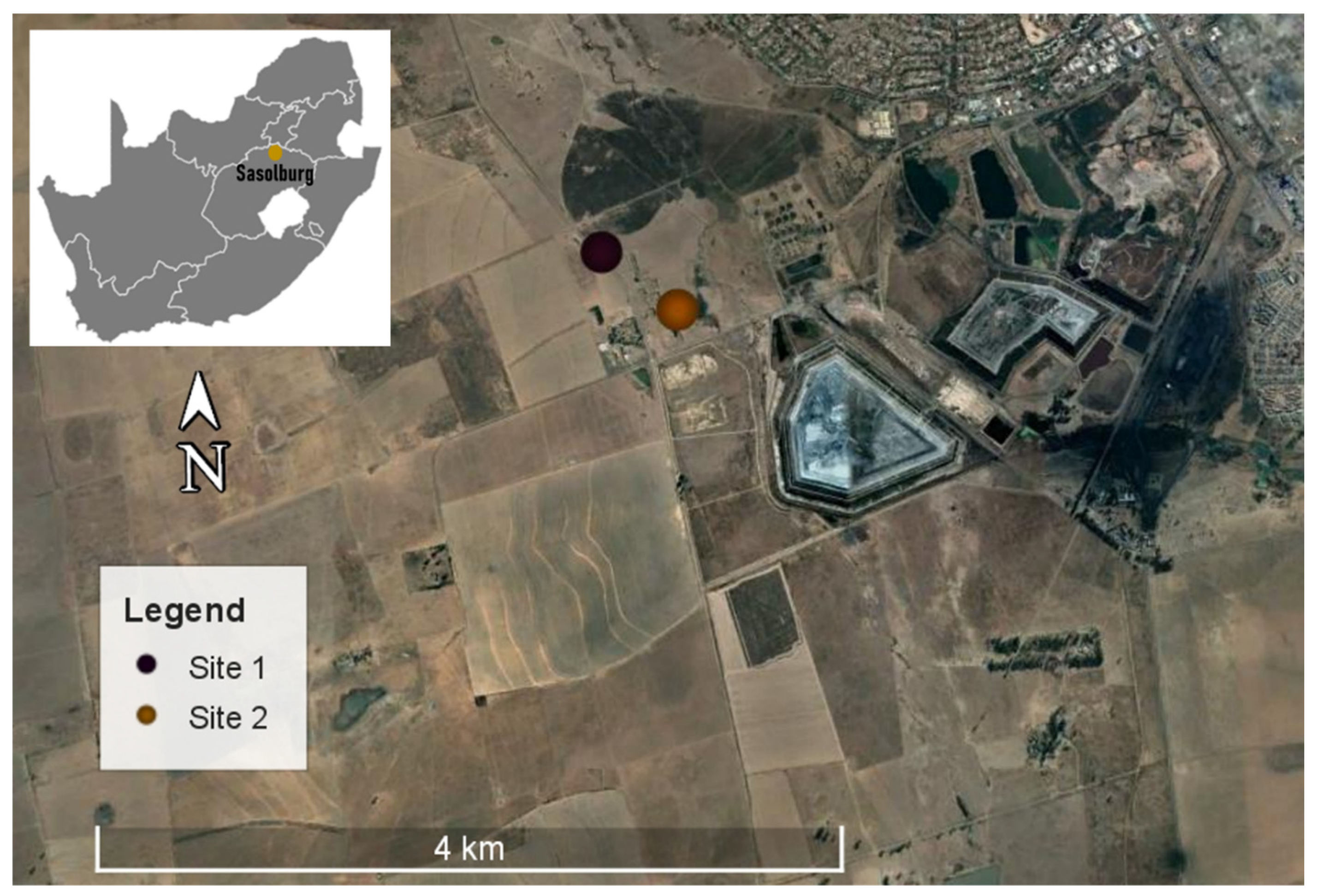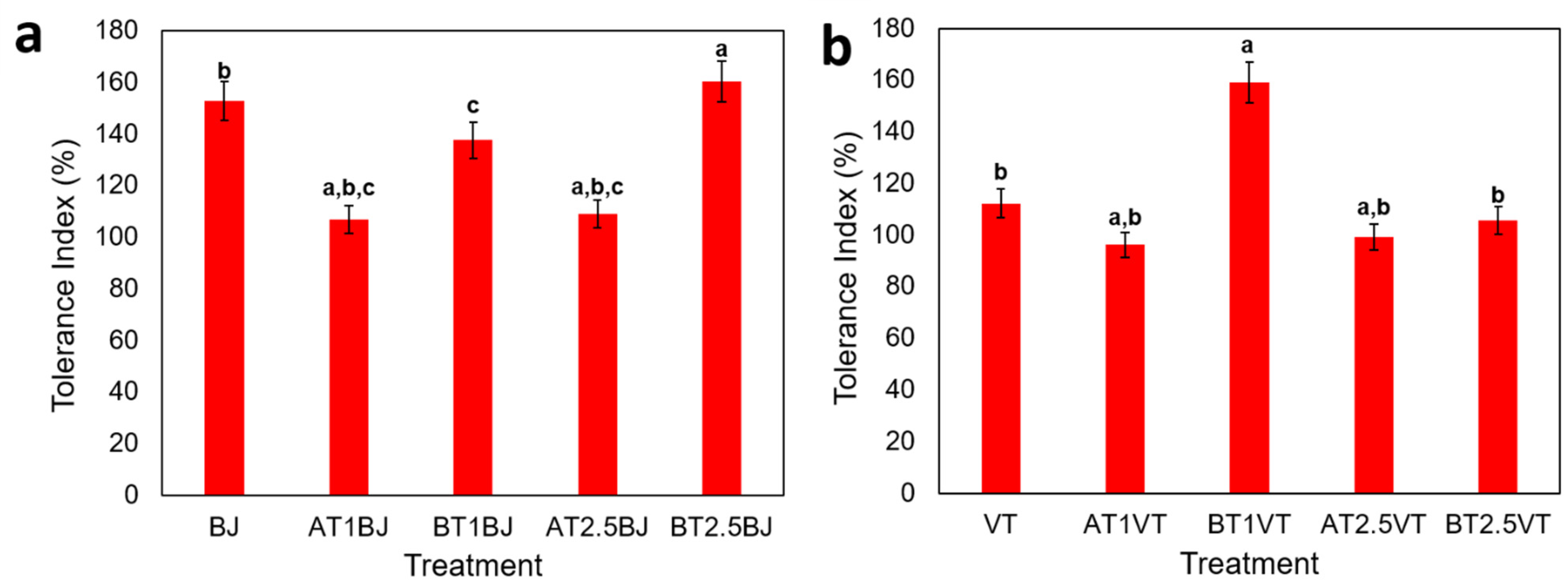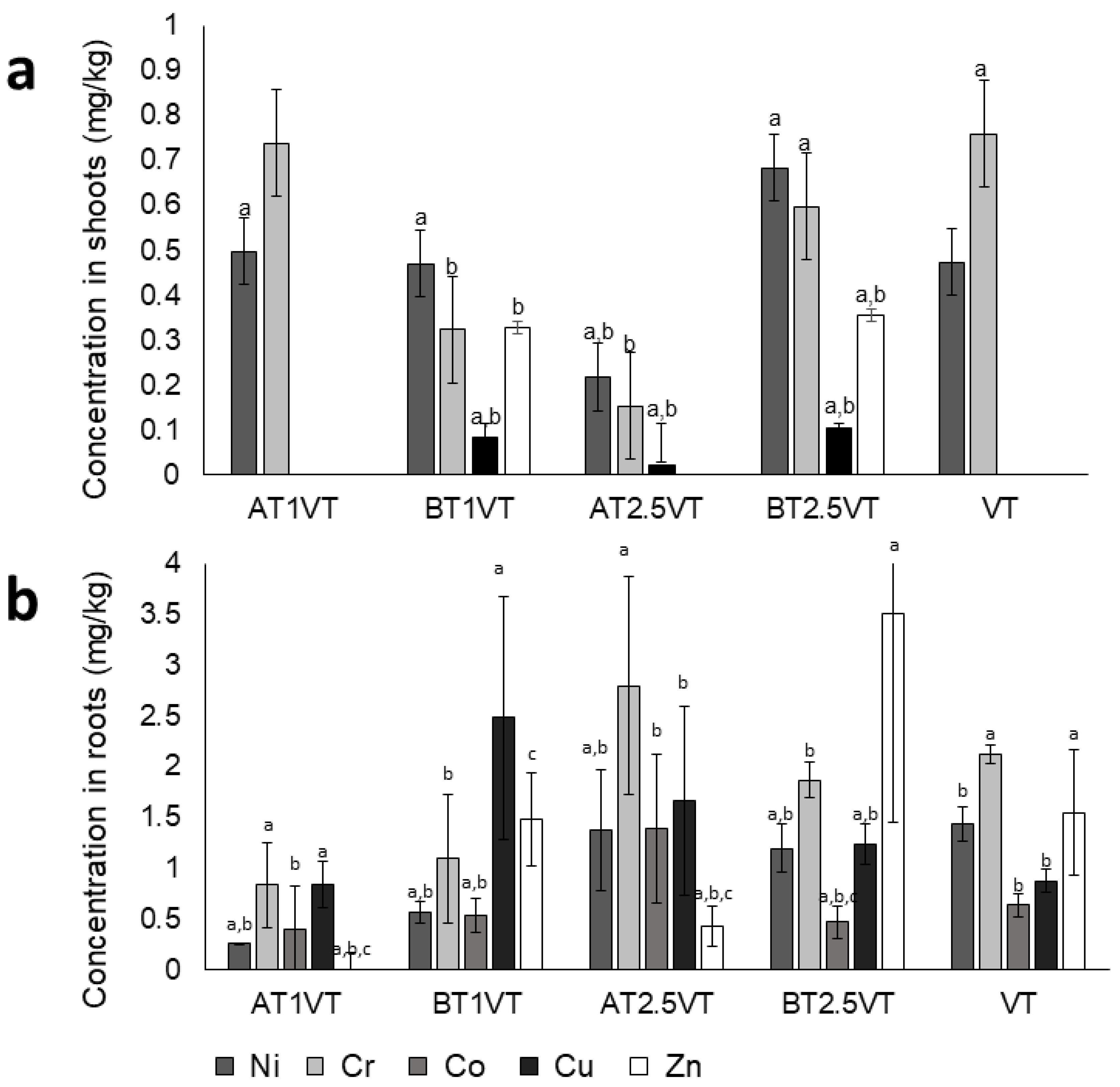Influence of Clay Mineral Amendments Characteristics on Heavy Metals Uptake in Vetiver Grass (Chrysopogon zizanioides L. Roberty) and Indian Mustard (Brassica juncea L. Czern)
Abstract
1. Introduction
2. Materials and Methods
2.1. Study Area
2.2. Sampling Procedure and Analyses
2.3. Seed Germination and Transplanting
2.4. Characterization of Bentonite and Attapulgite
2.5. Experimental Design
2.6. Harvesting and Analyses
2.7. Statistical Analyses
3. Results
3.1. Soil and Clay Characteristics
3.2. Responses of Plant Growth Tolerance Index (TI)
3.3. Accumulation of Heavy Metals in Vetiver Grass
3.4. Translocation Factor (TF)
3.5. Absorption of Heavy Metals in Indian Mustard
4. Discussion
5. Conclusions
Author Contributions
Funding
Institutional Review Board Statement
Informed Consent Statement
Data Availability Statement
Acknowledgments
Conflicts of Interest
References
- Maczkowiack, R.I.; Smith, C.; Erskine, P.D. Risk assessment models for post-mining land use. In Life of Mine Conference (AusIMM); The Australasian Institute of Mining and Metallurgy (AusIMM): Carlton, Australia, 2012; pp. 32–41. [Google Scholar]
- Ali, H.; Khan, E.; Sajad, M.A. Phytoremediation of heavy metals—Concepts and applications. Chemosphere 2013, 91, 869–881. [Google Scholar] [CrossRef] [PubMed]
- Zhu, Y.-G.; Pilon-Smits, E.A.H.; Zhao, F.-J.; Williams, P.N.; Meharg, A.A. Selenium in higher plants: Understanding mechanisms for biofortification and phytoremediation. Trends Plant Sci. 2009, 14, 436–442. [Google Scholar] [CrossRef] [PubMed]
- Zhang, X.; Gao, B.; Xia, H. Effect of cadmium on growth, photosynthesis, mineral nutrition and metal accumulation of bana grass and vetiver grass. Ecotoxicol. Environ. Saf. 2014, 106, 102–108. [Google Scholar] [CrossRef] [PubMed]
- Ng, C.C.; Boyce, A.N.; Abas, M.R.; Mahmood, N.Z.; Han, F. Evaluation of Vetiver Grass Uptake Efficiency in Single and Mixed Heavy Metal Contaminated Soil. Environ. Process. 2020, 7, 207–226. [Google Scholar] [CrossRef]
- Wuana, R.A.; Okieimen, F.E. Heavy Metals in Contaminated Soils: A Review of Sources, Chemistry, Risks and Best Available Strategies for Remediation. Int. Sch. Res. Not. 2011, 2011, 402647. [Google Scholar] [CrossRef]
- Simiele, M.; Lebrun, M.; Miard, F.; Trupiano, D.; Poupart, P.; Forestier, O.; Scippa, G.S.; Bourgerie, S.; Morabito, D. Assisted phytoremediation of a former mine soil using biochar and iron sulphate: Effects on as soil immobilization and accumulation in three Salicaceae species. Sci. Total Environ. 2020, 710, 136203. [Google Scholar] [CrossRef]
- Wessels, L. Decant of Sigma Colliery. Ph.D. Thesis, University of the Free State, Bloemfontein, Free State Province, South Africa, June 2013. [Google Scholar]
- Yan, T.; Zhao, W.; Yu, X.; Li, H.; Gao, Z.; Ding, M.; Yue, J. Evaluating heavy metal pollution and potential risk of soil around a coal mining region of Tai’an City, China. Alex. Eng. J. 2022, 61, 2156–2165. [Google Scholar] [CrossRef]
- Gulati, K.; Banerjee, B.; Lall, S.B.; Ray, A. Effects of diesel exhaust, heavy metals and pesticides on various organ systems: Possible mechanisms and strategies for prevention and treatment. Indian J. Exp. Biol. 2010, 48, 710–721. [Google Scholar]
- Liu, X.; Wang, Z.; Bai, H.; Zhang, S.; Mu, L.; Peng, L. Characteristics and health risk assessments of heavy metals in PM2.5 in Taiyuan and Yuci college town, China. Air Qual. Atmosphere Heal. 2020, 13, 909–919. [Google Scholar] [CrossRef]
- Mishra, S.; Chowdhary, P.; Bharagava, R.N. Conventional Methods for the Removal of Industrial Pollutants, Their Merits and Demerits. In Emerging and Eco-Friendly Approaches for Waste Management; Springer: Singapore, 2019; pp. 1–31. [Google Scholar] [CrossRef]
- Suelee, A.L.; Hasan, S.N.M.S.; Kusin, F.M.; Yusuff, F.M.; Ibrahim, Z.Z. Phytoremediation Potential of Vetiver Grass (Vetiveria zizanioides) for Treatment of Metal-Contaminated Water. Water Air Soil Pollut. 2017, 228, 158. [Google Scholar] [CrossRef]
- Yan, A.; Wang, Y.; Tan, S.N.; Yusof, M.L.M.; Ghosh, S.; Chen, Z. Phytoremediation: A Promising Approach for Revegetation of Heavy Metal-Polluted Land. Front. Plant Sci. 2020, 11, 359. [Google Scholar] [CrossRef] [PubMed]
- Meyers, D.E.; Auchterlonie, G.J.; Webb, R.I.; Wood, B. Uptake and localisation of lead in the root system of Brassica juncea. Environ. Pollut. 2008, 153, 323–332. [Google Scholar] [CrossRef] [PubMed]
- Herzig, R.; Nehnevajova, E.; Pfistner, C.; Schwitzguebel, J.-P.; Ricci, A.; Keller, C. Feasibility of Labile Zn Phytoextraction Using Enhanced Tobacco and Sunflower: Results of Five- and One-Year Field-Scale Experiments in Switzerland. Int. J. Phytoremediation 2014, 16, 735–754. [Google Scholar] [CrossRef] [PubMed]
- Li, J.; Zhang, J.; Larson, S.L.; Ballard, J.H.; Guo, K.; Arslan, Z.; Ma, Y.; Waggoner, C.A.; White, J.R.; Han, F.X. Electrokinetic-enhanced phytoremediation of uranium-contaminated soil using sunflower and Indian mustard. Int. J. Phytoremediation 2019, 21, 1197–1204. [Google Scholar] [CrossRef] [PubMed]
- Andra, S.S.; Datta, R.; Sarkar, D.; Saminathan, S.K.; Mullens, C.P.; Bach, S.B. Analysis of phytochelatin complexes in the lead tolerant vetiver grass [Vetiveria zizanioides (L.)] using liquid chromatography and mass spectrometry. Environ. Pollut. 2009, 157, 2173–2183. [Google Scholar] [CrossRef] [PubMed]
- Banerjee, R.; Goswami, P.; Pathak, K.; Mukherjee, A. Vetiver grass: An environment clean-up tool for heavy metal contaminated iron ore mine-soil. Ecol. Eng. 2016, 90, 25–34. [Google Scholar] [CrossRef]
- Gravand, F.; Rahnavard, A.; Pour, G.M. Investigation of Vetiver Grass Capability in Phytoremediation of Contaminated Soils with Heavy Metals (Pb, Cd, Mn, and Ni). Soil Sediment Contam. Int. J. 2021, 30, 163–186. [Google Scholar] [CrossRef]
- Shu, W.S.; Xia, H.P.; Zhang, Z.Q.; Lan, C.Y.; Wong, M.H. Growth and accumulation of heavy metals in four grasses grown on Pb/Zn mine tailings at Lechang of Guangdong Province China. Int. J. Phytoremediation 2002, 4, 47–57. [Google Scholar] [CrossRef]
- Wilde, E.; Brigmon, R.; Dunn, D.; Heitkamp, M.; Dagnan, D. Phytoextraction of lead from firing range soil by Vetiver grass. Chemosphere 2005, 61, 1451–1457. [Google Scholar] [CrossRef]
- Singh, S.; Suvarna, S.; Kumar, K.; Fulzele, D.P. Investigation of arsenic accumulation and biochemical response of in vitro developed Vetiveria zizanoides plants. Ecotoxicol. Environ. Saf. 2017, 145, 50–56. [Google Scholar] [CrossRef]
- Van Huysen, T.; Terry, N.; Pilon-Smits, E.A.H. Exploring the Selenium Phytoremediation Potential of Transgenic Indian Mustard Overexpressing ATP Sulfurylase or Cystathionine-γ-Synthase. Int. J. Phytoremediation 2004, 6, 111–118. [Google Scholar] [CrossRef] [PubMed]
- Chigbo, C.; Batty, L.; Bartlett, R. Interactions of copper and pyrene on phytoremediation potential of Brassica juncea in copper–pyrene co-contaminated soil. Chemosphere 2013, 90, 2542–2548. [Google Scholar] [CrossRef] [PubMed]
- Rathore, S.S.; Shekhawat, K.; Dass, A.; Kandpal, B.K.; Singh, V.K. Phytoremediation Mechanism in Indian Mustard (Brassica juncea) and Its Enhancement Through Agronomic Interventions. Proc. Natl. Acad. Sci. India Sect. B Boil. Sci. 2017, 89, 419–427. [Google Scholar] [CrossRef]
- Graziani, N.S.; Salazar, M.J.; Pignata, M.L.; Rodriguez, J.H. Assessment of the root system of Brassica juncea (L.) czern. and Bidens pilosa L. exposed to lead polluted soils using rhizobox systems. Int. J. Phytoremediation 2016, 18, 235–244. [Google Scholar] [CrossRef] [PubMed]
- Mahar, A.; Wang, P.; Ali, A.; Awasthi, M.K.; Lahori, A.H.; Wang, Q.; Li, R.; Zhang, Z. Challenges and opportunities in the phytoremediation of heavy metals contaminated soils: A review. Ecotoxicol. Environ. Saf. 2016, 126, 111–121. [Google Scholar] [CrossRef] [PubMed]
- Jaskulak, M.; Grobelak, A.; Vandenbulcke, F. Modelling assisted phytoremediation of soils contaminated with heavy metals—Main opportunities, limitations, decision making and future prospects. Chemosphere 2020, 249, 126196. [Google Scholar] [CrossRef]
- Kamusoko, R.; Jingura, R.M. Utility of Jatropha for Phytoremediation of Heavy Metals and Emerging Contaminants of Water Resources: A Review. CLEAN Soil Air Water 2017, 45, 1700444. [Google Scholar] [CrossRef]
- Liphadzi, M.; Kirkham, M. Availability and plant uptake of heavy metals in EDTA-assisted phytoremediation of soil and composted biosolids. S. Afr. J. Bot. 2006, 72, 391–397. [Google Scholar] [CrossRef]
- Novo, L.A.B.; Castro, P.M.L.; Alvarenga, P.; Da Silva, E.F. Plant Growth–Promoting Rhizobacteria-Assisted Phytoremediation of Mine Soils. In Bio-Geotechnologies for Mine Site Rehabilitation; Elsevier: Amsterdam, The Netherlands, 2018; pp. 281–295. [Google Scholar]
- Rathika, R.; Srinivasan, P.; Alkahtani, J.; Al-Humaid, L.; Alwahibi, M.S.; Mythili, R.; Selvankumar, T. Influence of biochar and EDTA on enhanced phytoremediation of lead contaminated soil by Brassica juncea. Chemosphere 2021, 271, 129513. [Google Scholar] [CrossRef]
- Gautam, M.; Agrawal, M. Phytoremediation of metals using vetiver (Chrysopogon zizanioides (L.) Roberty) grown under different levels of red mud in sludge amended soil. J. Geochem. Explor. 2017, 182, 218–227. [Google Scholar] [CrossRef]
- Salam, M.M.A.; Mohsin, M.; Kaipiainen, E.; Villa, A.; Kuittinen, S.; Pulkkinen, P.; Pelkonen, P.; Pappinen, A. Biomass growth variation and phytoextraction potential of four Salix varieties grown in contaminated soil amended with lime and wood ash. Int. J. Phytoremediation 2019, 21, 1329–1340. [Google Scholar] [CrossRef] [PubMed]
- Zotiadis, V.; Argyraki, A. Development of innovative environmental applications of attapulgite clay. Bull. Geol. Soc. Greece 2013, 47, 992. [Google Scholar] [CrossRef][Green Version]
- Otunola, B.O.; Ololade, O.O. A review on the application of clay minerals as heavy metal adsorbents for remediation purposes. Environ. Technol. Innov. 2020, 18, 100692. [Google Scholar] [CrossRef]
- Guo, H.; Xia, K.; Cao, M.; Zhang, X. Surface Modification of Attapulgite by Grafting Cationic Polymers for Treating Dye Wastewaters. Materials 2021, 14, 792. [Google Scholar] [CrossRef]
- Alabarse, F.; Conceição, R.V.; Balzaretti, N.M.; Schenato, F.; Xavier, A.M. In-situ FTIR analyses of bentonite under high-pressure. Appl. Clay Sci. 2011, 51, 202–208. [Google Scholar] [CrossRef]
- Digby Wells Environmental. Available online: https://sahris.sahra.org.za/sites/default/files/additionaldocs/SAS5250_Draft_BAR_Surface_Mitigation_Measures_2018-10-12_CW_KG.pdf (accessed on 1 May 2020).
- Madanan, M.T.; Shah, I.K.; Varghese, G.K.; Kaushal, R.K. Application of Aztec Marigold (Tagetes erecta L.) for phytoremediation of heavy metal polluted lateritic soil. Environ. Chem. Ecotoxicol. 2021, 3, 17–22. [Google Scholar] [CrossRef]
- Gavlak, R.; Horneck, D.; Miller, R.O.; Kotuby-Amacher, J. Soil, Plant and Water Reference Methods for the Western Region; WCC-103 Publication: Fort Collins, CO, USA, 2003. [Google Scholar]
- US EPA Method 3052 Microwave Assisted Acid Digestion of Siliceous and Organically Based Matrices. Available online: https://www.epa.gov/sites/production/files/2015-12/documents/3052.pdf (accessed on 7 June 2020).
- Raj, D.; Kumar, A.; Maiti, S.K. Brassica juncea (L.) Czern. (Indian mustard): A putative plant species to facilitate the phytoremediation of mercury contaminated soils. Int. J. Phytoremediation 2020, 22, 733–744. [Google Scholar] [CrossRef]
- Dogan, M.; Dogan, A.U.; Yesilyurt, F.I.; Alaygut, D.; Buckner, I.; Wurster, D.E. Baseline studies of The Clay Minerals Society special clays: Specific surface area by the Brunauer Emmett Teller (BET) method. Clays Clay Miner. 2007, 55, 534–541. [Google Scholar] [CrossRef]
- Macht, F.; Eusterhues, K.; Pronk, G.J.; Totsche, K.U. Specific surface area of clay minerals: Comparison between atomic force microscopy measurements and bulk-gas (N2) and -liquid (EGME) adsorption methods. Appl. Clay Sci. 2011, 53, 20–26. [Google Scholar] [CrossRef]
- Nabaei, M.; Amooaghaie, R. Melatonin and nitric oxide enhance cadmium tolerance and phytoremediation efficiency in Catharanthus roseus (L.) G. Don. Environ. Sci. Pollut. Res. 2020, 27, 6981–6994. [Google Scholar] [CrossRef]
- R Development Core Team. R: A Language and Environment for Statistical Computing. R Foundation for Statistical Computing, Vienna, Austria. Available online: https://www.release.org.uk/sites/default/files/pdf/publications/A%20Quiet%20Revolution%20-%20Decriminalisation%20Across%20the%20Globe.pdf (accessed on 1 June 2020).
- Kumararaja, P.; Manjaiah, K.; Datta, S.; Sarkar, B. Remediation of metal contaminated soil by aluminium pillared bentonite: Synthesis, characterisation, equilibrium study and plant growth experiment. Appl. Clay Sci. 2017, 137, 115–122. [Google Scholar] [CrossRef]
- Mi, J.; Gregorich, E.G.; Xu, S.; McLaughlin, N.B.; Liu, J. Effect of bentonite as a soil amendment on field water-holding capacity, and millet photosynthesis and grain quality. Sci. Rep. 2012, 10, 1–11. [Google Scholar] [CrossRef] [PubMed]
- Suppadit, T.; Kitikoon, V.; Phubphol, A.; Neumnoi, P. Effect of Quail Litter Biochar on Productivity of Four New Physic Nut Varieties Planted in Cadmium-Contaminated Soil. Chil. J. Agric. Res. 2012, 72, 125–132. [Google Scholar] [CrossRef]
- Rahman, M.M.; Azirun, S.M.; Boyce, A.N. Enhanced Accumulation of Copper and Lead in Amaranth (Amaranthus paniculatus), Indian mustard (Brassica juncea) and Sunflower (Helianthus annuus). PLoS ONE 2013, 8, e62941. [Google Scholar] [CrossRef]
- De Bernardi, A.; Casucci, C.; Businelli, D.; D’Amato, R.; Beone, G.M.; Fontanella, M.C.; Vischetti, C. Phytoremediation Potential of Crop Plants in Countering Nickel Contamination in Carbonation Lime Coming from the Sugar Industry. Plants 2020, 9, 580. [Google Scholar] [CrossRef]
- Sharma, S.S.; Dietz, K.-J.; Mimura, T. Vacuolar compartmentalization as indispensable component of heavy metal detoxification in plants. Plant Cell Environ. 2016, 39, 1112–1126. [Google Scholar] [CrossRef]
- Yang, W.; Luo, L.; Bostick, B.C.; Wiita, E.; Cheng, Y.; Shen, Y. Effect of combined arsenic and lead exposure on their uptake and translocation in Indian mustard. Environ. Pollut. 2021, 274, 116549. [Google Scholar] [CrossRef]
- Ma, Y.; Rajkumar, M.; Freitas, H. Inoculation of plant growth promoting bacterium Achromobacter xylosoxidans strain Ax10 for the improvement of copper phytoextraction by Brassica juncea. J. Environ. Manag. 2009, 90, 831–837. [Google Scholar] [CrossRef]
- Mbangi, A.; Muchaonyerwa, P.; Zengeni, R. Accumulation of multiple heavy metals in plants grown on soil treated with sewage sludge for more than 50 years presents health risks and an opportunity for phyto-remediation. Water SA 2018, 44, 569–576. [Google Scholar] [CrossRef]
- Chaudhry, H.; Nisar, N.; Mehmood, S.; Iqbal, M.; Nazir, A.; Yasir, M. Indian Mustard Brassica juncea efficiency for the accumulation, tolerance and translocation of zinc from metal contaminated soil. Biocatal. Agric. Biotechnol. 2020, 23, 101489. [Google Scholar] [CrossRef]
- Goswami, S.; Das, S. A Study on Cadmium Phytoremediation Potential of Indian mustard, Brassica juncea. Int. J. Phytoremediation 2015, 17, 583–588. [Google Scholar] [CrossRef] [PubMed]




| Treatment Code | Conditions |
|---|---|
| Control (zero treatment) | Soil with no treatment |
| VT | Vetiver only (one plant per pot) |
| BJ | Indian mustard only (one plant per pot) |
| AT1VT | Attapulgite + Vetiver applied at 1% (w/w) |
| AT2.5VT | Attapulgite + Vetiver applied at 2.5% (w/w) |
| BT1VT | Bentonite + Vetiver applied at 1% (w/w) |
| BT2.5VT | Bentonite + Vetiver applied at 1% (w/w) |
| AT1BJ | Attapulgite + Vetiver applied at 1% (w/w) |
| AT2.5BJ | Attapulgite + Vetiver applied at 2.5% (w/w) |
| BT1BJ | Bentonite + Vetiver applied at 1% (w/w) |
| BT2.5BJ | Bentonite + Vetiver applied at 2.5% (w/w) |
| VTC | Vetiver only in uncontaminated soil |
| BJC | Indian mustard only in uncontaminated soil |
| Parameter (Unit) | Value |
|---|---|
| pH | 6.80 ± 0.20 |
| N (%) | 0.01 ± 0.00 |
| C (%) | 1.31 ± 0.09 |
| Soil texture | Loam |
| Sand (%) | 42.80 ± 8.87 |
| Silt (%) | 34.70 ± 0.61 |
| Clay (%) | 22.50 ± 0.09 |
| Mineralogy (%) | |
| Quartz | 78.00 ± 0.14 |
| Plagioclase | 7.00 ± 0.17 |
| Potassium feldspar | 5.00 ± 0.17 |
| Mica | 6.00 ± 0.15 |
| Serpentine | 4.00 ± 0.06 |
| Total trace elements (mg/kg) | |
| Cr | 151.00 ± 8.39 |
| Ni | 50.50 ± 2.75 |
| Co | 26.00 ± 1.40 |
| Cu | 25.00 ± 0.92 |
| Zn | 57.50 ± 1.16 |
| Heavy Metal/ Treatment | Co | Cr | Cu | Ni | Zn |
|---|---|---|---|---|---|
| VT | 0 | 0.4 ± 0.08 b | 0 | 0.4 ± 0.11 | 0 |
| AT1VT | 0 | 0.9 ± 0.44 a | 0 | 2.0 ± 0.82 | 0 |
| BT1VT | 0 | 0.3 ± 0.82 | 0.1 ± 0.13 | 0.9 ± 0.24 | 0.3 ± 0.07 |
| AT2.5VT | 0 | 0.1 ± 0.02 | 0.1 ± 0.07 | 0.2 ± 0.06 a | 0 |
| BT2.5VT | 0 | 0.4 ± 0.02 ab | 0.1 ± 0.01 | 0.6 ± 0.34 | 0.2 ± 0.35 |
Publisher’s Note: MDPI stays neutral with regard to jurisdictional claims in published maps and institutional affiliations. |
© 2022 by the authors. Licensee MDPI, Basel, Switzerland. This article is an open access article distributed under the terms and conditions of the Creative Commons Attribution (CC BY) license (https://creativecommons.org/licenses/by/4.0/).
Share and Cite
Otunola, B.O.; Aghoghovwia, M.P.; Thwala, M.; Gómez-Arias, A.; Jordaan, R.; Hernandez, J.C.; Ololade, O.O. Influence of Clay Mineral Amendments Characteristics on Heavy Metals Uptake in Vetiver Grass (Chrysopogon zizanioides L. Roberty) and Indian Mustard (Brassica juncea L. Czern). Sustainability 2022, 14, 5856. https://doi.org/10.3390/su14105856
Otunola BO, Aghoghovwia MP, Thwala M, Gómez-Arias A, Jordaan R, Hernandez JC, Ololade OO. Influence of Clay Mineral Amendments Characteristics on Heavy Metals Uptake in Vetiver Grass (Chrysopogon zizanioides L. Roberty) and Indian Mustard (Brassica juncea L. Czern). Sustainability. 2022; 14(10):5856. https://doi.org/10.3390/su14105856
Chicago/Turabian StyleOtunola, Beatrice Omonike, Makhosazana P. Aghoghovwia, Melusi Thwala, Alba Gómez-Arias, Rian Jordaan, Julio Castillo Hernandez, and Olusola Oluwayemisi Ololade. 2022. "Influence of Clay Mineral Amendments Characteristics on Heavy Metals Uptake in Vetiver Grass (Chrysopogon zizanioides L. Roberty) and Indian Mustard (Brassica juncea L. Czern)" Sustainability 14, no. 10: 5856. https://doi.org/10.3390/su14105856
APA StyleOtunola, B. O., Aghoghovwia, M. P., Thwala, M., Gómez-Arias, A., Jordaan, R., Hernandez, J. C., & Ololade, O. O. (2022). Influence of Clay Mineral Amendments Characteristics on Heavy Metals Uptake in Vetiver Grass (Chrysopogon zizanioides L. Roberty) and Indian Mustard (Brassica juncea L. Czern). Sustainability, 14(10), 5856. https://doi.org/10.3390/su14105856







